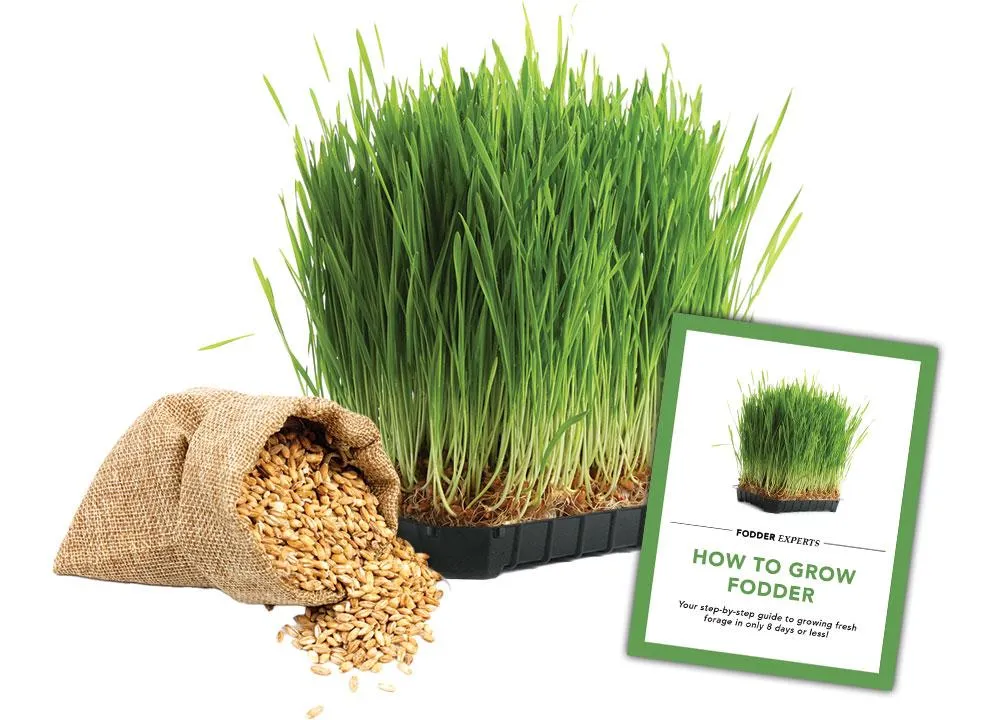Due to the popularity of our Fodder Growing Kits, they may sell out! As of today, we do have a limited supply IN STOCK and ready to ship straight to you!
Claim Your FREE Fodder Growing Kit! Only Pay Shipping & Handling!


1lb of barley seed (This will produce 6-8lbs of fresh fodder!)
A reusable growing tray
Step-by-step growing instructions to produce fodder in 8 days or less
I’d like to rush a FREE growing kit so that you can try growing your own fodder, ASAP!
All that you need to do is send me your address and cover the cost of shipping & handling.
Available to US and Canada only due to customs and import restrictions*


Fodder FAQs
What is Fodder?
Fodder is the end product of sprouting a seed, most commonly barley! It is ready to feed in just 8 Days and turns 1lb of seed into as much as 8lbs of fodder! This fresh, delicious, and highly nutritious forage is best compared to a high quality grass hay or a low quality alfalfa.
WARNING: It is NOT just like HAY
Is Fodder a hay or grain replacement?
Fodder CAN help us reduce the need for concentrated grains significantly and even cut back on a percentage of hay being fed, but that does not make it a hay replacement! There are several reasons it is not a hay replacement. First- fodder has a high concentration of water (average 85%) therefore meaning it has a dry matter of about 15%. This means 10lbs of fodder has 1.5lbs of dry matter. This is why you cannot replace 10lbs of hay which is 90% dry matter with 10lbs of fodder that is 15% dry matter.
The second significant reason is the calcium to phosphorous ratio. Fodder’s calcium to phosphorous ratio is approximately 0.125:1. This is important because horses need a 1 to 1 ratio, cattle a 1.5 to 1 ratio, chickens a 2 to 1 ratio. Overcoming this can easily be done by providing your animals with dry forage such as grass or alfalfa hay! On average grass hay has a 1 to 1-2 (calcium to phosphorous) ratio where alfalfa on average has a 5 to 1 ratio. This is why we use fodder along side our dry forage feeding program to help maximize our horse’s healthy!
What animals eat fodder?
Here is a straight forward rule of thumb: If they eat grass as a regular part of their diet, fodder can be a great addition to their feeding program!So if you have any of the following, but not limited to:
Horses
Cattle
Rabbits
Sheep
Goats
Pigs
Donkeys & Mules
Chickens
Llamas
and even cats, especially house cats who don’t have access to fresh grass!
Is Fodder safe for all animals?
Owners with animals with health issues such as thyroid problems, IR (insulin resistance), prone to be laminitic among others that are negatively impacted by certain diets should be very cautious when feeding fodder to these types of animals. It may be wise to steer clear of feeding fodder all together to some individual animals while others may be OK receiving small quantities. One must simply look objectively at the animal’s health, consult your veterinarian and make a decision that is in the best interest of the animal’s health.
Is Fodder easy to grow?
Fodder is super simple, EVEN IF YOU DO NOT have a ‘green thumb’! There is NO soil or fertilizer required! And even NO grow lights required! This is what is so amazing about fodder! All you need is a little space, your seed and trays!
Do I have to grow Fodder inside or outside?
Fodder grows best in temperatures of 65 to 75 degrees Fahrenheit or 18 to 24 degrees Celsius. Therefore fodder can be grown either outside or inside as long as it has access to those temperatures! If grown outside in a windy or more dry climate your fodder may need to be watered more frequently.
Do you have a full nutrition analysis available?
This is the best info available to date but it hasn’t been enough to satisfy us frankly because there’s holes- why? Many of the past studies had specific objectives or were measuring specific factors therefore resulting in isolated information while other details not being accounted for. In our study we’re aiming for a comprehensive nutritional analysis with that being the sole focus.
Because of this we are in the process of conducting a study with one of the leading animal nutrition labs in the world with the sole objective to get as much information about barley fodder and everything that makes it what it is so that you can be informed and make the best decisions for your animals. As soon as this data is available we’ll be sending the results straight to you and making them available for as many as possible!
Until then, here at the numbers currently available based on other studies.For comparison, fodder is often compared to a high quality grass hay or low quality alfalfa hay.
Here is why:
Protein 14-18%
Dry Matter 15%
Digestibility 90%+
Is very rich in: vitamin A, vitamin E, vitamin C, thiamin, riboflavin, niacin, biotin, free folic acid, anti-oxidants like β-carotene and minerals. Some studies have shown a 10-20 times increase in these vitamins & minerals in comparison to what is present in a dormant barley seed.
It is important to keep in mind many factors such as watering, seed quality and plant health can influence the exact nutritional value in which your fodder has. By following our step by step process to growing your fodder you can be sure you’re on the path to maximizing your yields and the nutritional quality of your fodder for you animals!
How much Fodder will my Growing Kit produce?
Your kit comes with 1lb of barley seed. This will produce up to 8lbs of fresh fodder.